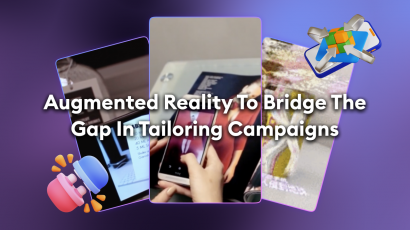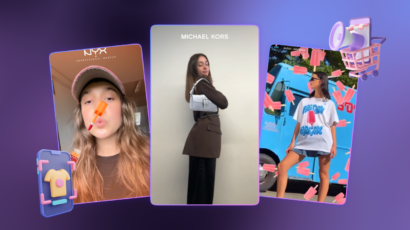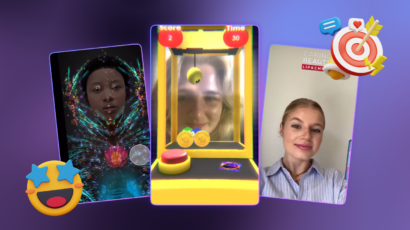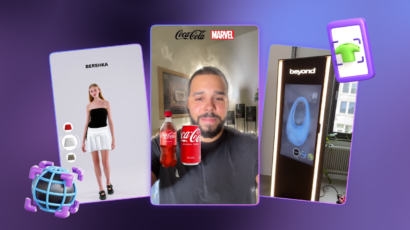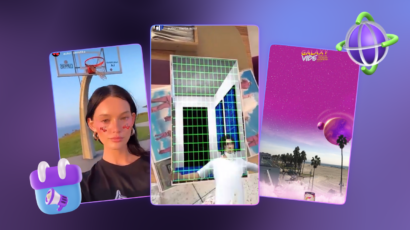In a world where technology is constantly reshaping our experience, Augmented reality (AR) has evolved as a game-changing tool for both businesses and consumers. With AR, the virtual and physical worlds are combined, as opposed to Virtual Reality (VR), which entirely immerses users in a digital environment. Users are able to engage with digital objects and data while still being conscious of their immediate surroundings. This important distinction has opened up a wide range of innovative opportunities for businesses to engage their audience and produce memorable experiences.
AR has grown exponentially in recent years, revolutionizing many different businesses in the process. Total AR & VR revenue is anticipated to more than double by 2027. As a result, revenue will surpass $50 billion and reach $52.05 billion.
Augmented Reality: The Key to Personalized Marketing and Engaging Consumers
The difficulty of customizing ads to specific consumers has long been a problem for marketers. Modern consumers are looking for personalized and relevant experiences, therefore mass advertising frequently fails to capture their attention. It has been a constant challenge for marketers to pinpoint the particular tastes of each customer and offer personalized communications.
By utilizing the power of AR, creative marketers have discovered a solution to this problem. Brands can now build highly personalized experiences that connect with specific customers on a deeper level by using AR in their marketing. Customers may virtually try things before buying them, see how the furniture fits in their houses, and even see how a new hairstyle enhances their appearance with AR-powered applications. This degree of personalization encourages a stronger emotional bond between the customer and the company in addition to increasing engagement.
Customers are more likely to make lasting impressions and spread their experiences with others when they can actively interact and engage with a brand’s products. Campaigns utilizing augmented reality make inactive bystanders into active participants, giving them a sense of value and participation. This increases user-generated content production and brand loyalty while also expanding the campaign’s reach.
Augmented Reality Marketing: Outperforming Traditional Methods with Exceptional Engagement
Augmented Reality is reshaping industries across the board. From retail and entertainment to healthcare and education, businesses are leveraging AR to capture customers’ attention and provide unforgettable experiences. Marketing campaigns powered by AR have demonstrated exceptional engagement rates compared to traditional methods.
One notable example is Hector&Karger’s RE_ALITY campaign for their AW 15/16 collection. By using image tracking developed in partnership with Tap2C, the brand provided readers with an interactive lookbook experience. Users engaged with the AR experience 65% longer than traditional print ads, resulting in increased brand recognition and a 30% boost in click-through rates to the Hector&Karger website. Moreover, 12% of the collection’s overall income was attributed to direct sales through the AR experience.
Empowering Personalized Experiences With AR
One of the significant challenges faced by marketers is customizing campaigns to individual consumers. Modern consumers seek personalized and relevant experiences, making mass advertising less effective. AR offers a solution by enabling brands to build highly personalized experiences tailored to each customer.
The Watsons AR marketing campaign for their new carbonated beverage “X Soda” was a resounding success in addressing their pain points and accomplishing their goals among Generation Z consumers. Watsons produced an immersive experience with the well-known Gen Z influencer, Virtual imma, by utilizing AR object tracking in an offline situation.
By scanning the “X Soda” can, users could enter an immersive pink world where Virtual Imma and the product appeared in a contemporary city, surrounded by enigmatic space-time signals and unidentified energies. This creative strategy not only raised brand recognition but also significantly enhanced sales among the Generation Z target market.
The campaign also promoted social media sharing, which organically increased brand visibility and reach. Watsons effectively connected with their target audience by fusing the appeal of Virtual Imma with the immersive AR metaverse, strengthening their emotional connection to the brand, and encouraging loyal customer behavior towards “X Soda.”
As for the tailored and personalized experiences, Absolut Vodka’s AR campaign was also a huge success. The brand used a smartphone app to provide users with a 3D tour of their vodka manufacturing location in Hus, Sweden. This immersive experience not only increased brand mentions on social media by 30% but also influenced 25% of respondents to express a higher propensity to purchase Absolut vodka after the tour. By tailoring the campaign with AR, Absolut successfully connected with its target audience and increased purchase intent.
Unleashing the Psychological Power With AR
AR has a profound psychological impact on consumers, elevating their engagement with brands. By blurring the lines between reality and fantasy, AR-powered experiences leave consumers feeling amazed and delighted, fostering a stronger emotional bond between customers and companies.
Moreover, the concept of “gamification” takes AR to a new level. Brands can transform routine interactions into fun challenges, incorporating interactive and immersive experiences with AR. This taps into the human desire for accomplishment and recognition, encouraging users to devote time and effort to these experiences. As a result, engagement rates soar, and consumers are more likely to share their AR-powered adventures, expanding the campaign’s reach.
Pizza Hut used AR to enhance its dining experience and address key issues. By integrating AR into their smartphone app, users could scan pizza boxes and menus for interactive gamified elements, leading to a 40% increase in app engagement. This strategy also boosted conversion rates, with a 25% rise in orders placed through the app.
The campaign received positive feedback from 85% of users, demonstrating how AR can create enjoyable brand experiences. By encouraging customers to share their interactive dining experiences on social media, brand achieved a 30% increase in brand mentions and improved social media reach. Overall, Pizza Hut’s use of AR showcased them as a customer-focused brand, providing a distinctive and memorable dining experience.
AR: The Future of Tailored Campaigns and Unparalleled Engagement
Implementing AR into marketing campaigns requires a strategic approach. Marketers must set clear objectives, understand their target audience, and choose the appropriate AR technology based on campaign goals. A seamless user experience is crucial for success, and brands should extensively test their AR applications to identify and address any issues before launch.
As AR technology continues to advance, the future of marketing is set to be even more exciting and immersive. The incorporation of AR into social media platforms creates endless opportunities for imaginative and engaging marketing efforts that captivate users like never before.
Moreover, AR wearables, such as smart glasses and AR contact lenses, will seamlessly merge the physical and digital worlds. This level of personalization and ease of access will undoubtedly influence consumer behavior, leading them to seek out AR-enhanced experiences and impacting their purchasing decisions.
In conclusion, AR is driving unparalleled engagement and transforming the marketing landscape. Brands can create personalized, interactive, and unforgettable experiences that captivate audiences like never before. From immersive product displays to location-based AR advertising, the potential impact of AR on consumer behavior and marketing success is boundless. As the technology evolves, embracing AR becomes essential for staying ahead in the competitive landscape. It’s time for marketers to bravely embrace the AR revolution and create a future where marketing crosses boundaries, enthralls audiences, and fosters enduring brand loyalty. So if you’re ready to start this exciting journey, don’t miss the chance, schedule a consultation with us, and let’s embrace the world of endless possibilities.
